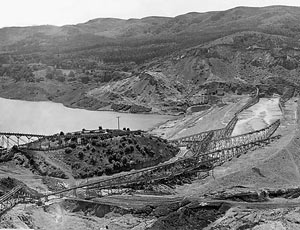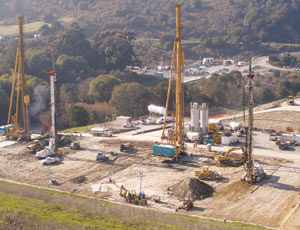To safeguard downstream residents, work now is under way in California to seismically upgrade the San Pablo Dam. The $54-million project involves removing an existing buttress, strengthening the downstream foundation using cement deep-soil mixing and constructing a new 85-ft-high by 950-ft-long buttress. The San Pablo Dam, located near El Sobrante, is an 89-year-old, 38,600 acre-ft drinking-water impoundment. It is managed by the East Bay Municipal Utility District (EBMUD), which serves 1.3 million people in parts of Alameda and Contra Costa counties.


A 2004 seismic stability study by Geomatrix Consultants Inc., Oakland, determined that foundation soils and the downstream shell were subject to liquefaction, and a 7.5-magnitude earthquake on the Richter scale could cause the dam to slump over 30 ft and flood downstream areas in Richmond, El Sobrante and San Pablo. The water district then lowered the water level and planned the upgrade.
“We had 15 ft of structural freeboard, and we added another 20 ft by drawing down water,” says Xavier J. Irias, EBMUD director of engineering and construction. “Removing the current buttress creates a level working area to soil-mix down to bedrock in order to strengthen the alluvium on which the dam was originally constructed.”
The joint venture of Terra Engineers Inc./Ninyo & Moore, San Francisco, designed the fix. “The biggest concern was that the conceptual design called for a lot of material to be imported from a borrow area with difficult access for heavy equipment,” says Guilaine Roussel, Terra project manager. “But supplemental investigations determined that the existing shell was stronger than expected and not susceptible to liquefaction, and the original cut-off trench was actually quite effective at limiting seepage and the amount of piezometric head downstream.” The joint venture was able to reduce the width of the soil-mix area from 200 ft to 150 ft and the volume of fill in the new buttress from 960,000 cu yd to 270,000 cu yd.
General contractor Sukut Construction Inc., Santa Ana, Calif., removed the buttress, and subcontractor Raito Inc., San Leandro, Calif., now is using two deep-soil mixing rigs, each with three 3-ft-dia. overlapping augers, to drill from 12-ft to 120-ft deep. “Cement deep-soil mixing elements are laid out in a grid pattern, with shear walls oriented perpendicular to the dam on 8-ft centers and longitudinal walls, which run parallel,” says A. David Miller, Raito senior vice president. “The shear walls must be keyed into bedrock a minimum of 3 ft.”
Crews from D.J. Scheffler Inc., Pomona, Calif., also are operating two auger rigs predrilling 3,000 to 4,000 holes to determine bedrock depth and to ensure penetration. The $35-million soil- mixing operation is scheduled for a September completion. The complete project will wrap up next June.
San Pablo Dam was built using hydraulic fill placement, basically Gold Rush technology in which fill was sluiced into place. EBMUD added the current downstream buttress after a similar dam—the Lower San Fernando Dam—experienced a near-failure in 1971 due to liquefaction in a 6.6-magnitude earthquake. In the 1980s, the district also installed an upstream buttress that is keyed into bedrock. “The San Fernando earthquake was a wake-up call to owners” to inspect and retrofit dams, says Irias. “When the new buttress is completed, we will have addressed the liquefaction concerns.”


Post a comment to this article
Report Abusive Comment